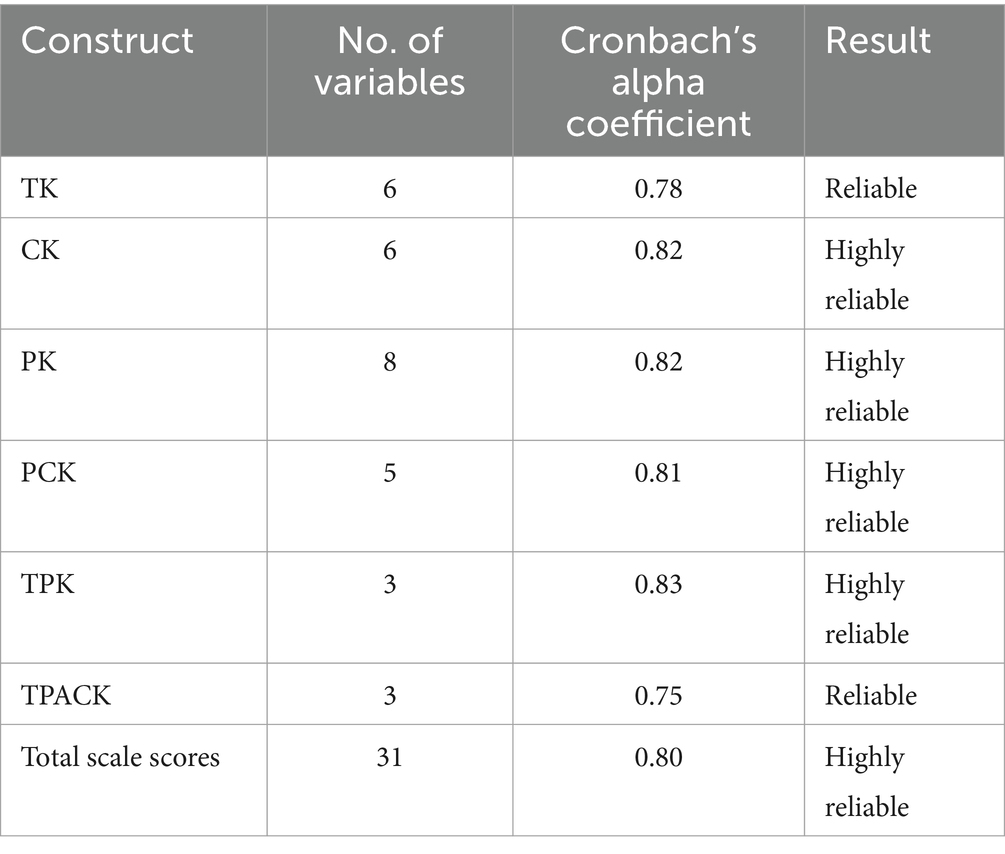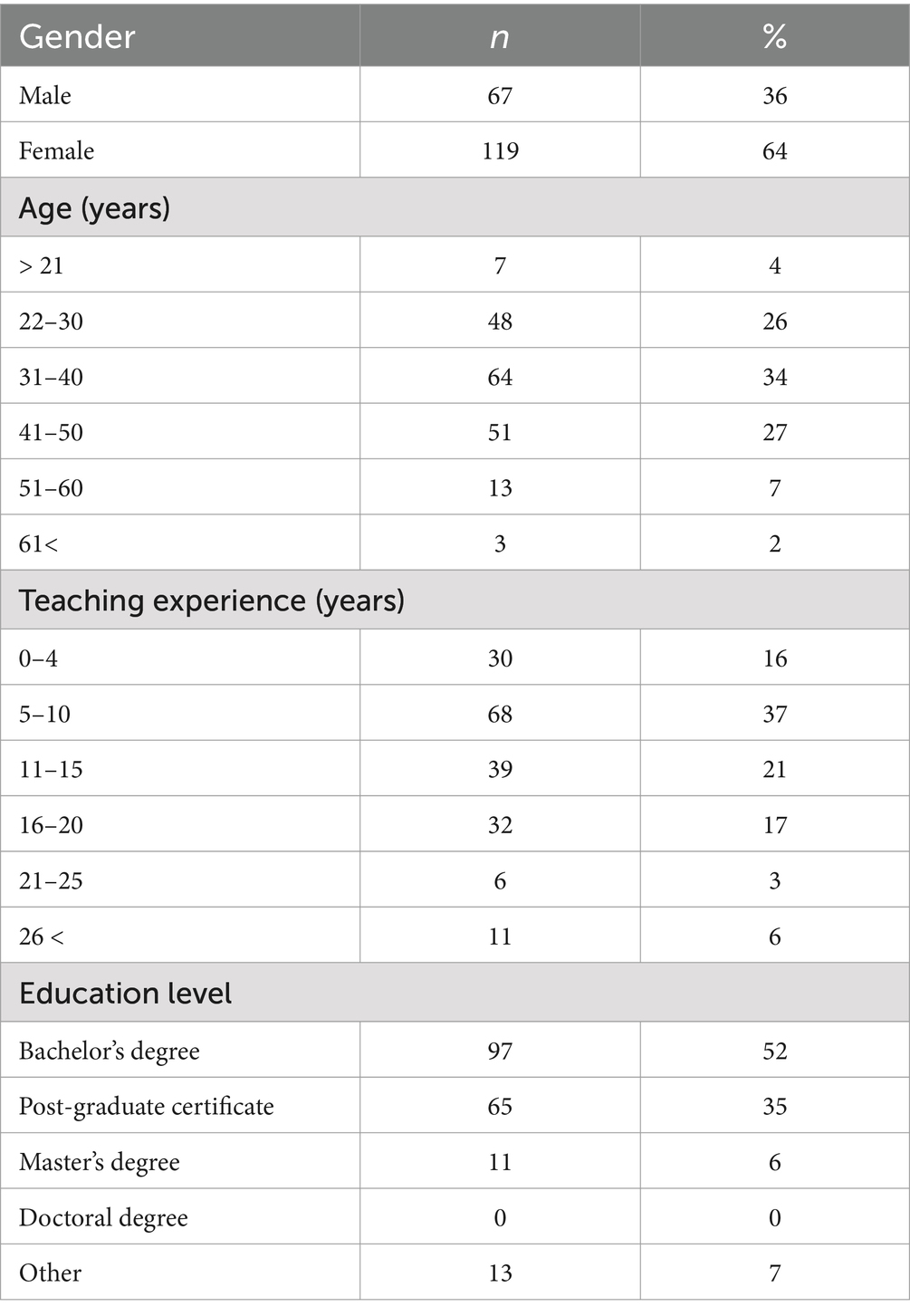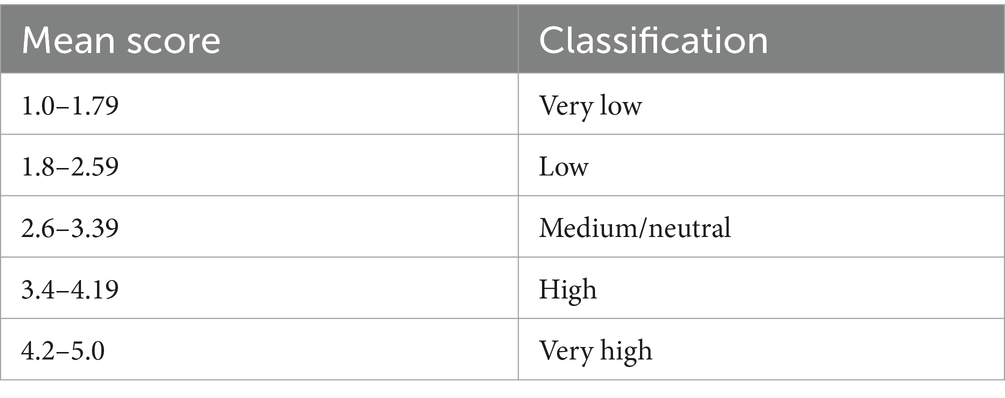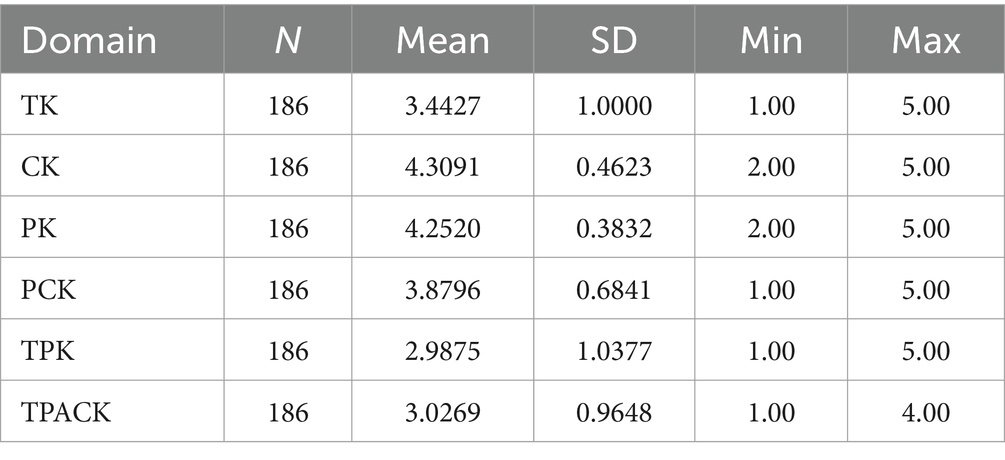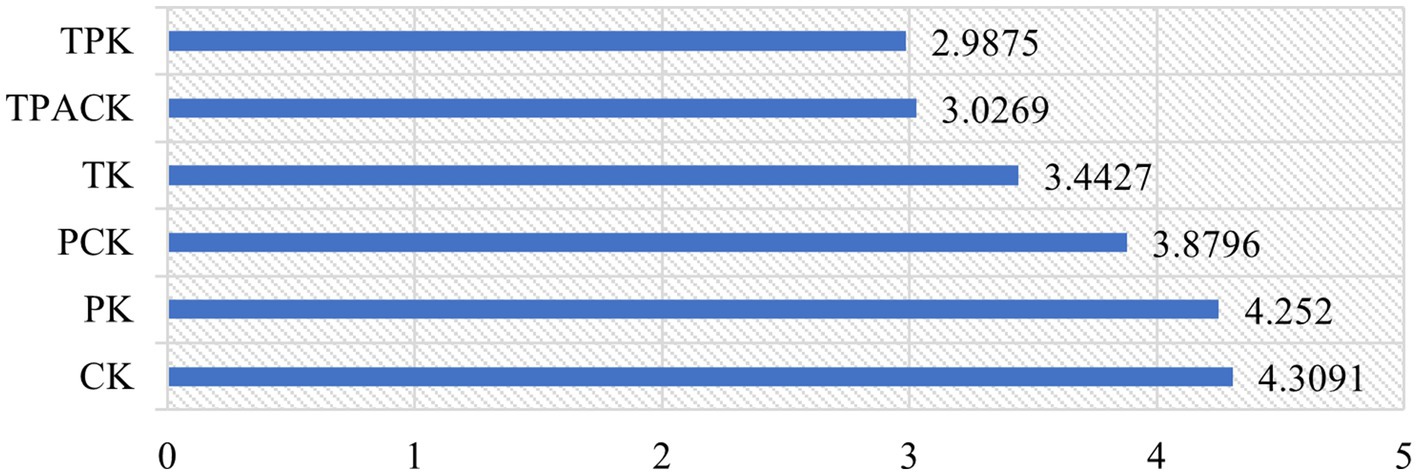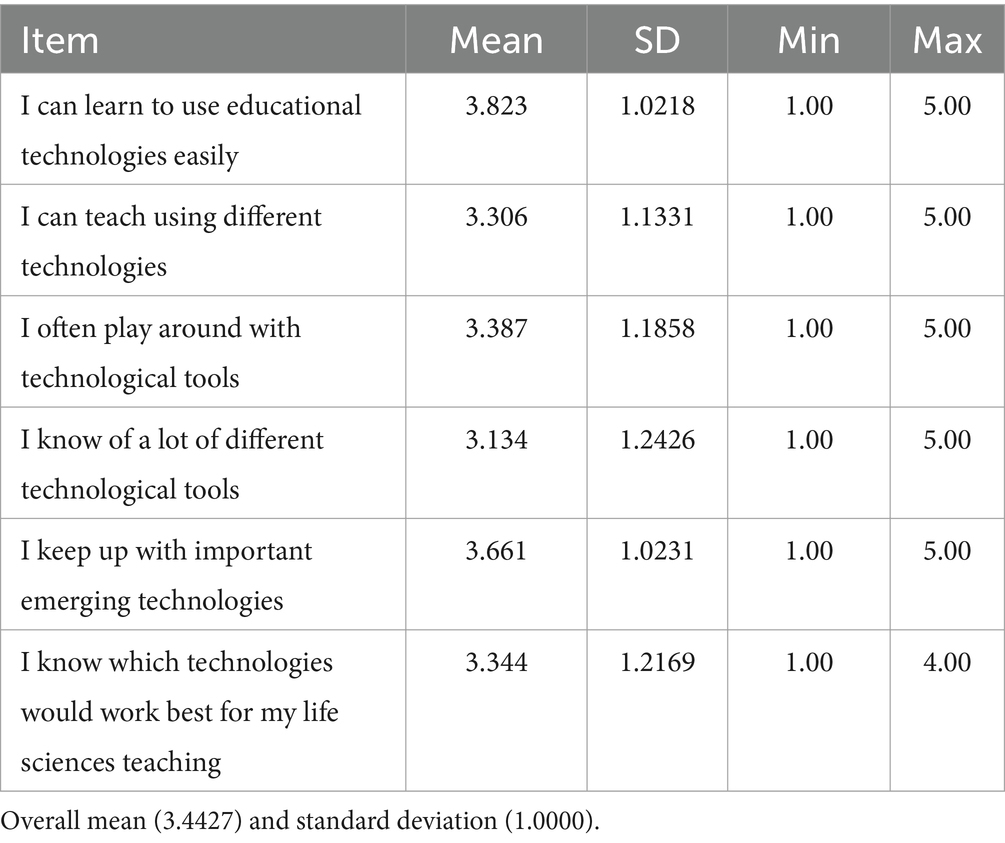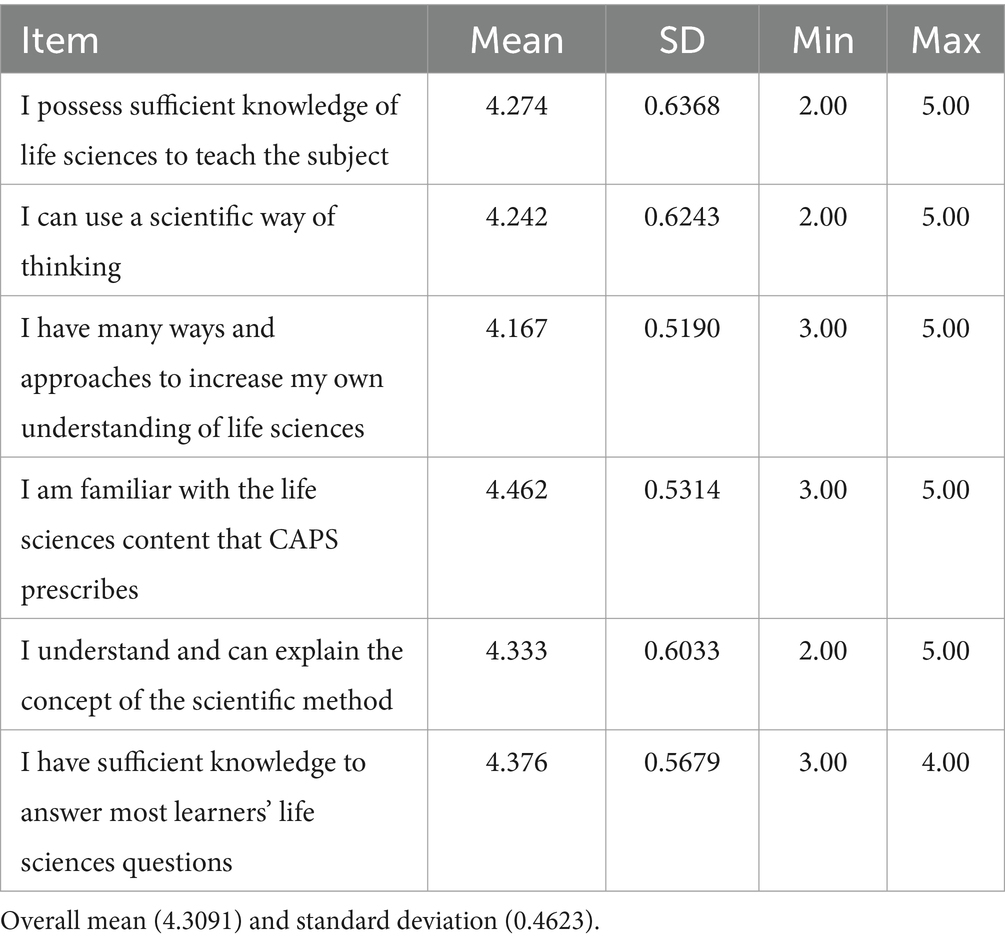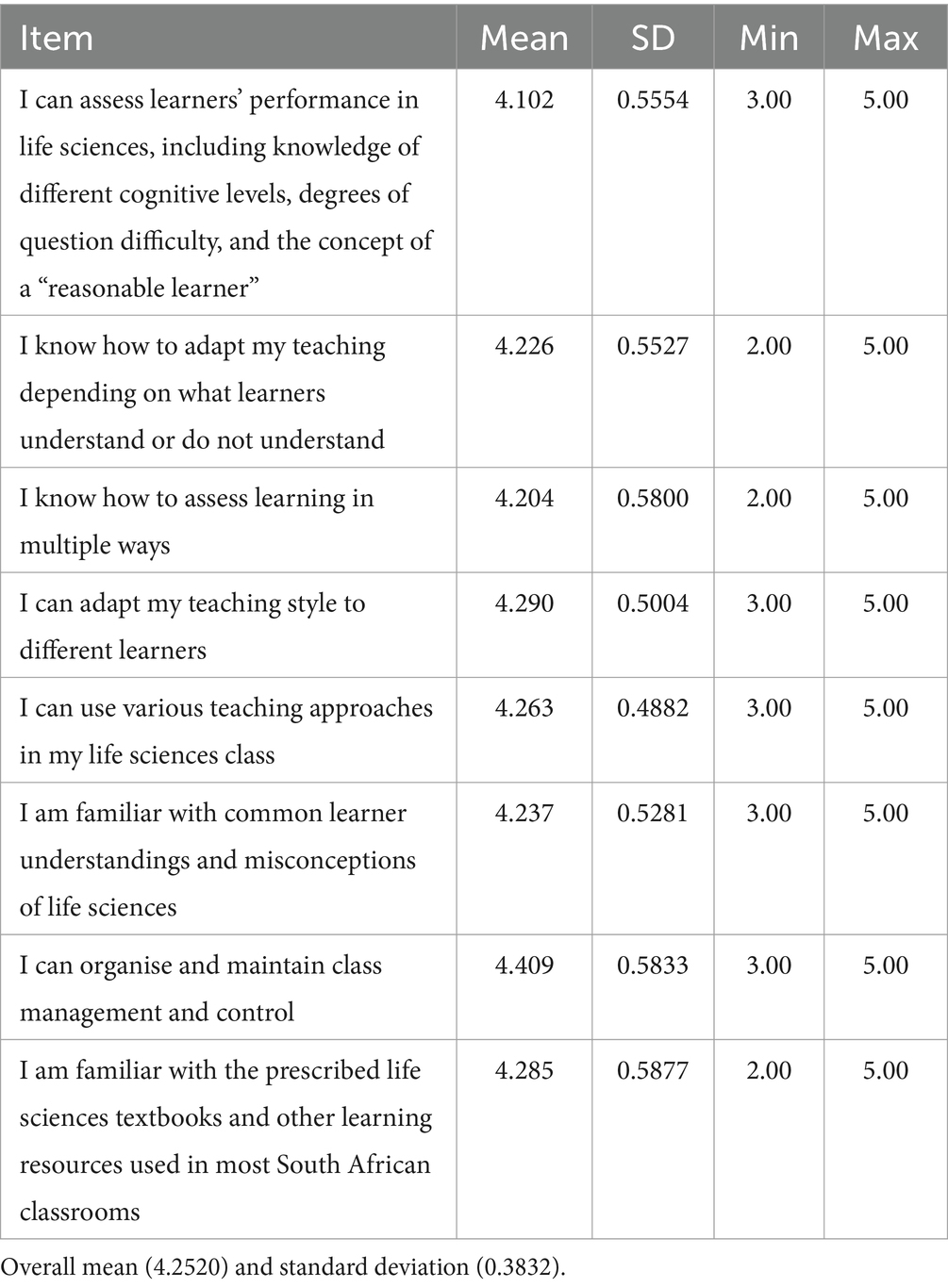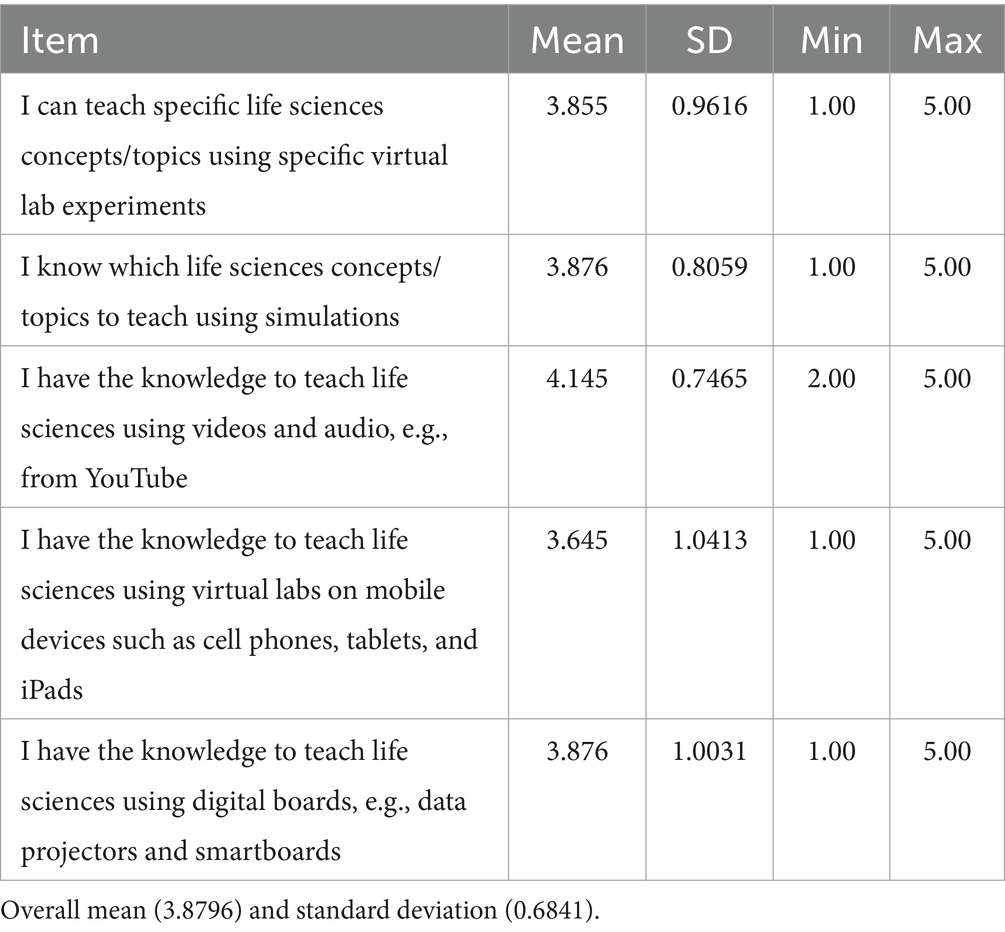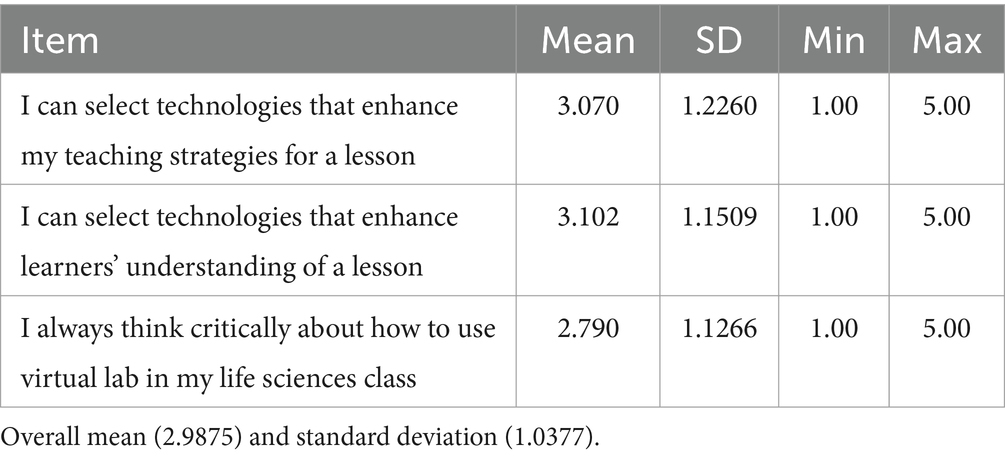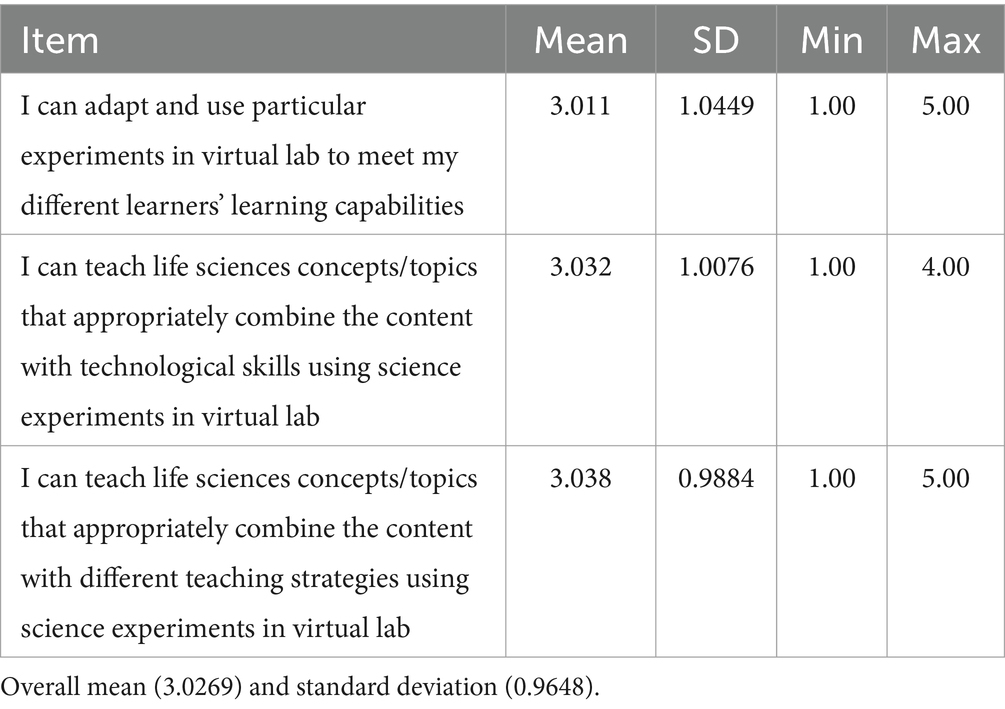- 1Department of Mathematics, Natural Sciences, and Technology Education, University of the Free State, Bloemfontein, South Africa
- 2Department of Curriculum Studies and Higher Education, University of the Free State, Bloemfontein, South Africa
Introduction: This paper reports on a sequential explanatory mixed-methods study that assessed technological, pedagogical and content knowledge (TPACK) competency among life sciences teachers in the context of virtual lab adoption in rural schools in South Africa.
Methods: Drawing from TPACK framework as the study’s theoretical foundation, data gathered through questionnaires (N = 186) and in-depth semi-structured interviews (N = 4) were analysed using descriptive and thematic analysis.
Results: The study uncovered a ubiquitous deficiency in TPACK competency among the participating life sciences teachers. The teachers demonstrated significant expertise in conventional areas such as content knowledge (CK), pedagogical knowledge (PK), and pedagogical content knowledge (PCK), mainly influenced by teaching experience. However, they exhibited a noticeable gap in technology-related TPACK domains, including technological knowledge (TK), technological pedagogical knowledge (TPK), and overall TPACK proficiency.
Discussion: This paper aspires to address a significant gap in educational research by spotlighting the often-overlooked rural teaching contexts. In addition, the paper advocates for tailored professional development initiatives to enhance teachers’ overall TPACK proficiency. Such initiatives are crucial for empowering teachers to integrate technology into their teaching and improve learning outcomes effectively.
1 Introduction
Teaching science has historically been recognised as a challenging endeavour. Central to its complexity is the inherently abstract nature of scientific concepts, demanding learners to possess advanced cognitive skills to comprehend and interconnect these abstract principles effectively (DeBoer, 2019; Dewey and Bentley, 1949; Lombardi and Bailey, 2024). Moreover, each major branch of science, including biology, chemistry, and physics, along with their respective sub-disciplines, utilises specialised terminology, adding another layer of complexity (Cíbiková and Petrášová, 2023). In rural schools, teaching science becomes even more challenging due to a host of unique difficulties. These challenges include low socio-economic status, inadequate resources and infrastructure, a shortage of science teachers, and the absence of fundamental science facilities such as laboratories (UNICEF, 2021). Furthermore, the research underscores that rural areas often experience political, social, and economic marginalisation, leading to the sidelining of rural teachers from national education dialogues and policy formulation. The geographical dispersion of rural schools, lengthy commutes, and subpar infrastructure further impede students’ access to quality science education (Drescher et al., 2022; Masinire, 2020). Additionally, the struggle to recruit and retain qualified, experienced teachers exacerbates these challenges, resulting in many rural schools being staffed with less experienced personnel (Ingersoll and Tran, 2023; Tran and Smith, 2020).
The adoption of novel technologies such as virtual laboratories (VLs) is increasingly reaching rural areas in the Global South, signifying a promising development in science education. As a subset of simulations, VLs draw upon models derived from physical laboratories, offering accessible and cost-effective alternatives to traditional lab setups (Lynch and Ghergulescu, 2017). Particularly beneficial in most rural schools lacking adequate lab infrastructure, VLs provide students with hands-on scientific experimentation opportunities. Moreover, VLs contribute to enhanced safety by eliminating risks associated with handling hazardous materials, while also accommodating scalability and fostering flexibility in learning (Potkonjak et al., 2016; Reginald, 2023). Interactivity within VLs enriches educational experiences, yet challenges persist in their integration. Issues such as the absence of tactile experience, reliance on technology, restricted experimentation scope, limited collaboration opportunities, potential student disengagement, and the necessity for comprehensive teacher training underscore the complexities in effectively incorporating VLs into rural science education (Mercado and Picardal, 2023; Pyatt and Sims, 2012). Addressing these challenges is imperative to fully leverage the potential of VLs in enhancing learning outcomes in underserved regions.
While VLs in rural schools can expand learning opportunities by offering access to otherwise unavailable experiments and resources, several challenges persist. For example, unreliable internet connectivity in many rural areas causes frequent disruptions, hindering consistent use (Ingersoll and Tran, 2023). Additionally, most schools in rural regions frequently face a shortage of necessary technical support for managing and troubleshooting VLs (Shambare et al., 2022). Furthermore, Shambare et al. (2022) noted that initial costs for technology infrastructure, devices, and training can be prohibitive for budget-constrained rural schools despite potential long-term savings. Beyond these drawbacks, scholars such as Cox (2013, p. 6) highlight an overarching challenge, noting that “teaching with technology is an arduous and complex job given the multifaceted sources of knowledge which need to be contextualised and negotiated.” In the same spirit, Omoso and Odindo (2020) assert that integrating new technologies into rural schools transforms the teaching environment. This adds another layer of complexity to the teaching process in rural schools. This contemporary context diverges from earlier notions of teacher knowledge, which mainly focussed on mastery of content and pedagogy as defining features of an expert teacher.
Historically, teacher competence was gauged by mastery of subject matter and effective teaching methods (Shulman, 1986). However, Shulman (1987) argued that this definition was insufficient and introduced “pedagogical content knowledge” (PCK) as a framework merging content knowledge (CK) and pedagogical knowledge (PK) to enhance understanding for learners. While Shulman’s perspective remains relevant (Shulman, 1987), the discourse has notably shifted with the proliferation of innovative technologies in teaching−learning spaces, even in remote and rural schools. The complexity of teaching with technology highlights the emergence of a new type of teacher knowledge that encompasses technology, pedagogy, and content.
In the contemporary discourse on teachers’ knowledge to leverage innovative technologies in teaching, Koehler and Mishra (2009) stress the importance of incorporating technology with a purposeful pedagogical approach. Expanding on this notion, Leahy and Mishra (2023) underscore the necessity for teachers to possess specialised knowledge, referred to as “technological pedagogical content knowledge” (TPACK) (Koehler and Mishra, 2006; Mishra et al., 2024). TPACK involves a deep understanding of how technology, content, and pedagogy interact to inform instructional strategies tailored to specific educational contexts (Koehler and Mishra, 2009). With the imminent widespread adoption of VLs in rural educational settings, it becomes imperative to assess teachers’ TPACK in these environments to support VL implementation into teaching in a meaningful way. In rural areas, where teachers may face additional challenges such as limited access to professional development resources and technical support (Omoso and Odindo, 2020), understanding their TPACK becomes even more critical. This understanding can guide targeted interventions and training programmes that address specific needs, ultimately enhancing the effectiveness of VLs and improving student outcomes. Presently, there is a noticeable disparity in research efforts, with fewer studies conducted in the Global South compared to the Global North, particularly concerning VL-related literature and TPACK exploration. Mishra (2019) underscores the significance of contextual factors in shaping teachers’ technological integration practices, emphasising the need for context-specific insights that may diverge from experiences in more developed educational landscapes. Thus, it is crucial to prioritise research endeavours in the Global South to ensure the applicability and effectiveness of educational technologies such as VLs across diverse educational settings. The paper addresses the question: What are life sciences teachers’ TPACK levels for virtual lab adoption in rural schools?
This paper makes significant contributions by assessing science teachers’ TPACK in rural schools. Their perspectives, often sidelined in discussions about integrating new technologies in science education, are crucial for understanding the educational landscape comprehensively. In addition, the paper stands out for its focus on secondary education, breaking away from the predominant focus on higher education in previous research. This shift towards investigating teachers’ TPACK in rural science teaching at the secondary level creates a pioneering research niche in South African science education. By delving into this less explored territory, our paper aspires to enhance existing knowledge and offer valuable insights tailored to the specific challenges and opportunities faced by secondary school science teachers in rural areas.
2 Assessing teachers’ TPACK
Technology integration in education has surged in recent years. At the core of this evolution lies TPACK, which acknowledges the interplay between technology, pedagogy, and content knowledge in effective teaching. The assessment of teachers’ TPACK is a focal point in educational research, providing insights into teachers’ readiness to enhance teaching with technology. In this section, we summarise studies that evaluated TPACK in diverse countries and settings.
First, Jita’s (2016) mixed-methods study in South Africa examined pre-service teachers’ (PSTs) self-perceived competence in using information and communication technologies (ICTs) for teaching. Data collection comprised a questionnaire (N = 103) and focus group interviews (N = 21). Findings reveal that PSTs have more substantial confidence in non-technology-related skills compared to TK, with significant variations in ICT competencies. The study recommends restructuring teacher preparation programmes to equip future teachers to utilise technology for teaching science.
Second, Omoso and Odindo’s (2020) descriptive study conducted in Kenya examined the self-reported TPACK of PSTs to enhance classroom practice. Through the analysis of data obtained from a questionnaire (N = 38), the study revealed that PSTs generally acknowledged the importance of integrating TK with TPACK. However, they expressed uncertainty regarding their proficiency in TK and identifying suitable technologies for teaching and learning within their subject domains. Notably, those pursuing arts-based subjects reported lower levels of TK and technological content knowledge (TCK) compared to their counterparts in science-based subjects, indicating areas of concern. The study recommends practical implications such as adopting strategies like learning by doing and promoting a growth mindset to address these challenges.
Third, Paristiowati et al. (2020) conducted qualitative descriptive research in Jakarta, analysing the profile of TPACK among PSTs. Data collection methods included questionnaires, assessment of lesson plans and content, observation of the learning process, and reflective journals. The study’s findings reveal that the proficiency of PSTs in utilising TPACK can be enhanced during the learning process, progressing from perception levels to the Cn (conception level) category through lesson study.
Fourth, Hill and Uribe-Florez’s (2020) concurrent mixed-method design in the United States measured teachers’ TPACK. The study utilised both a questionnaire and semi-structured interviews for data collection. Quantitative data were subjected to descriptive statistical analysis, while qualitative data underwent thematic analysis. Findings from the quantitative analysis reveal that teachers exhibited the highest confidence in their PK and the lowest confidence in their TK. Notably, the robust confidence in PK influenced teachers’ pedagogically oriented integration of technology.
Fifth, Mensah et al. (2021) conducted a descriptive survey in Ghana, examining teachers’ proficiency in integrating technology into their classrooms. Data from a questionnaire (n = 113) were analysed using descriptive statistics. The results indicate that teachers exhibited high levels of CK and PK in geography. However, they displayed lower confidence in TK and its integration into teaching and learning compared to CK and PK. Recommendations included integrating technology-focussed courses at the higher education level.
Sixth, in their study, Kumala et al. (2022) aimed to assess the TPACK of science teachers, while also exploring the influence of demographic factors such as gender, age, employment status, and teaching experience on teachers’ TPACK levels. Data collection involved a Likert scale questionnaire administered to 175 participants, supplemented by interviews. Confirmatory factor analysis (CFA) was employed for data analysis. The findings reveal that male teachers tended to exhibit higher TPACK scores compared to their female counterparts. Moreover, teachers below the age of 40 demonstrated stronger technological skills compared to older teachers. Furthermore, a positive correlation was observed between teachers’ TPACK levels and their teaching experience, suggesting an enhancement in TPACK proficiency with increased teaching tenure.
Seventh, Handika et al.’s (2023) quantitative study conducted in Indonesia examined the facets of TPACK among elementary school teachers. Data obtained via a questionnaire underwent descriptive statistical analysis. The average values for various components were as follows: TK = 3.15, PK = 3.25, CK = 3.20, TCK = 3.35, PCK = 3.40, TPK = 3.41, and TPACK = 3.50, all categorised as “good.” Notably, TPACK exhibited the highest mean value. The study suggested that teachers found integrating all components relatively easy, emphasising the necessity of balancing technology, pedagogy, and content knowledge.
Our examination of the existing literature revealed several gaps in research that we aim to address in this study. Initially, we noticed a significant emphasis on PSTs in previous studies on TPACK. Notably, Setiawan et al.’s (2019) review, covering the years 2011–2017, highlighted this trend by indicating that most studies (66%) focussed on PSTs, with only one-third (31%) examining in-service teachers. This observation underscores a notable lack of understanding regarding TPACK development among in-service teachers, especially when compared to their pre-service counterparts. Consequently, our study seeks to bridge this gap by investigating the TPACK development of in-service teachers, particularly in the life sciences field.
Furthermore, we noted a geographical disparity in the distribution of TPACK research. According to Handayani et al.’s (2023) bibliometric analysis, the USA emerged as the leading contributor to TPACK studies, followed by Türkiye, Australia, Singapore, and South Korea. This finding highlights a significant gap in research, with a disproportionately low number of studies conducted on TPACK in the Global South compared to the Global North. While some research has touched upon TPACK among teachers in developing nations, the focus has primarily been on PSTs. Therefore, our study seeks to enhance the existing knowledge by examining the TPACK of in-service teachers, particularly in the Global South, and offering insights into harnessing VLs in teaching within this context.
3 Theoretical framework: TPACK
The TPACK model, introduced by Koehler and Mishra (2006), outlines the essential knowledge teachers need for effective technology integration. Drawing from Shulman’s (1986) work, TPACK explores the convergence of pedagogy, content, and technology, offering insights into the impact technology has on teaching. Scholars such as Mishra (2019) and Leahy and Mishra (2023) emphasise the importance of TPACK in understanding the interplay of content expertise, pedagogy, and technology in classrooms. Mishra (2019, p. 13) argues regarding the direction in which TPACK directs attention:
New technological resources reshape pedagogical knowledge, content knowledge, and pedagogical content knowledge. Furthermore, effective teaching with technology is context-dependent, and it necessitates a profound understanding of how technology interacts with pedagogy and content.
Based on their insights, Koehler and Mishra (2006) define TPACK as the intricate interrelationships among three key components of teacher knowledge: CK (the subject matter), PK (teaching methods), and TK (integrating technology into teaching). They emphasise that:
Good teaching is not simply adding technology to the existing teaching and content domain. Instead, the introduction of technology causes the representation of new concepts. It requires developing a sensitivity to the dynamic, transactional relationship between all three components suggested by the TP[A]CK framework. (Koehler and Mishra, 2006, p. 22).
In addition, Mishra et al. (2022, p. 2198) recently added that TPACK (see Figure 1) “involves asking how technology can enhance and broaden effective teaching and learning within a particular discipline. This process also entails adapting to the changes in content and pedagogy that technology inherently introduces.”
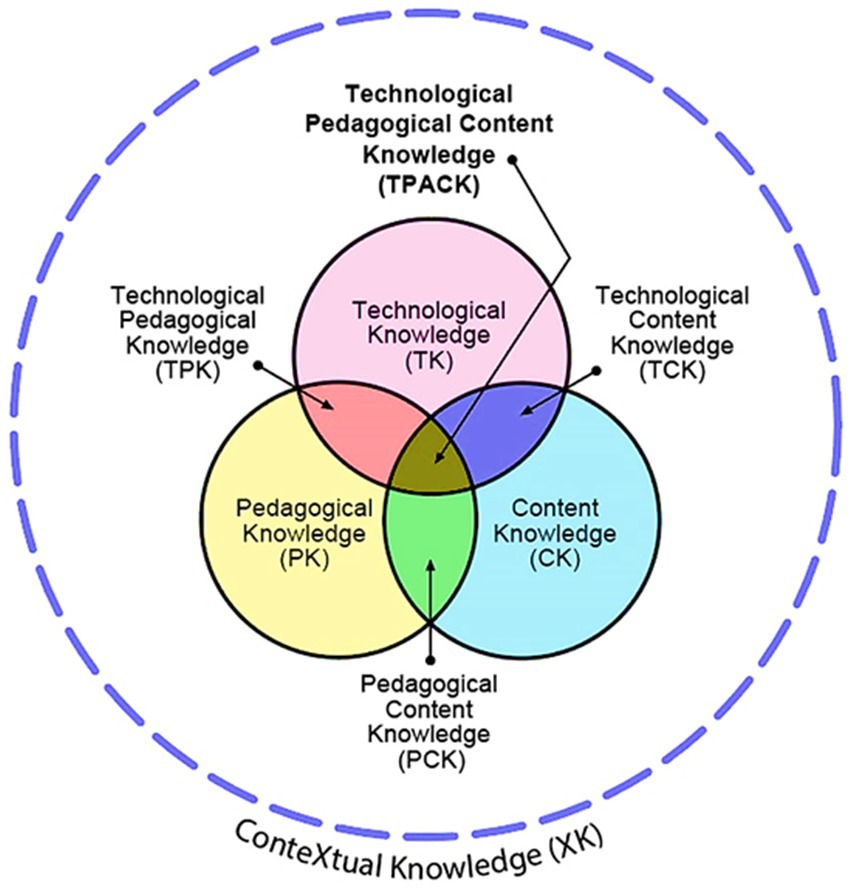
Figure 1. Updated TPACK diagram (Mishra, 2019, p. 2).
The resulting TPACK knowledge constructs are presented in Table 1.
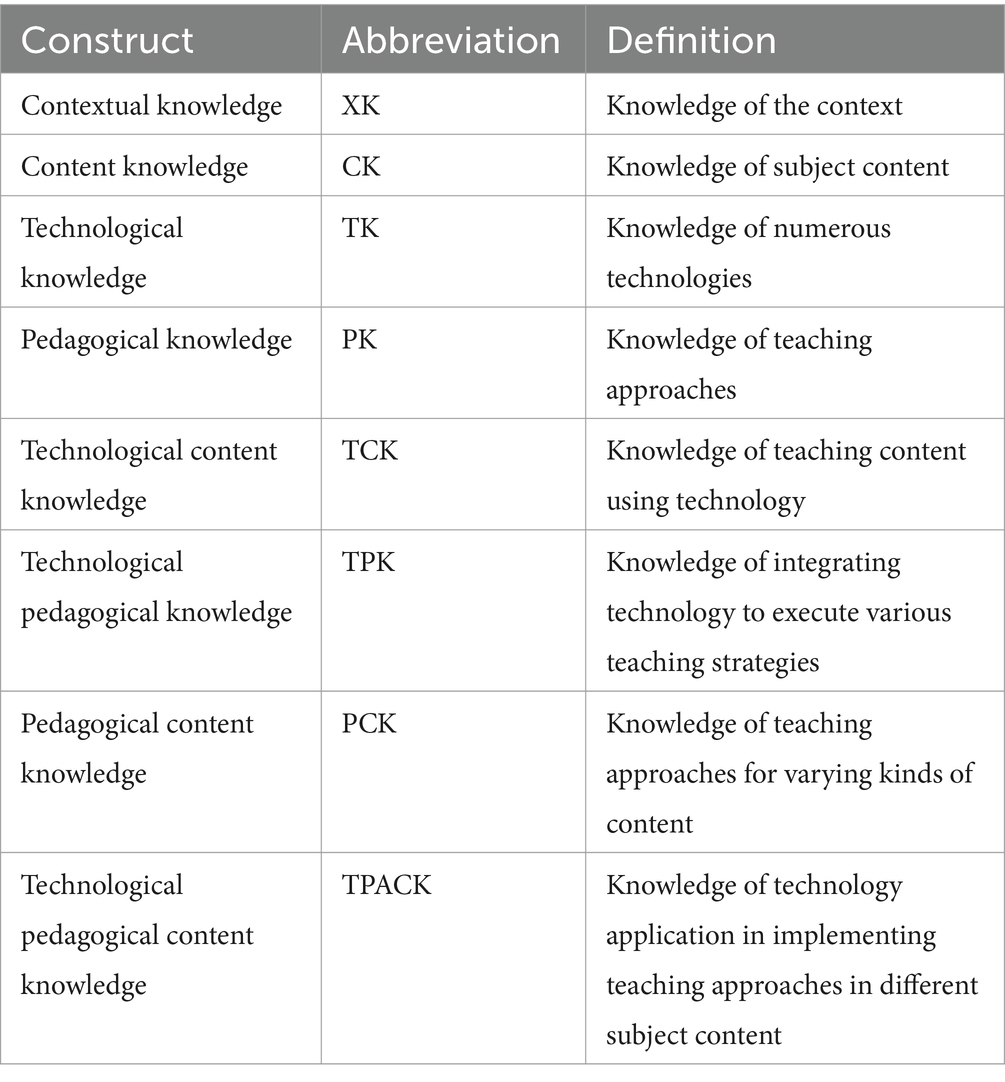
Table 1. TPACK framework constructs (Mishra, 2019, p. 9).
We adopted the TPACK framework in this study because it aligned with our objectives, particularly in exploring science teachers’ knowledge to leverage VLs in teaching. TPACK provided a lens for understanding the interplay between CK, pedagogical strategies, and technological integration in teaching. Despite some reported shortcomings, such as a lack of specificity in teaching objectives and methods, TPACK remains valuable for examining the multifaceted nature of technology use in education.
4 Methods
4.1 Study design
We employed a sequential explanatory mixed-methods design comprising two phases. Phase 1 entailed quantitative data collection and analysis via a questionnaire survey. Phase 2 involved conducting semi-structured interviews to delve deeper into acquiring the sought-after knowledge.
4.2 Questionnaire design
This study employed a measurement scale adapted from Schmidt et al. (2009), utilising a 5-point Likert scale ranging from 1 (strongly disagree) to 5 (strongly agree). The survey consisted of two sections: The first gathered demographic information (7 items), and the second focussed on TPACK constructs (TK = 6 items, PK = 8 items, PCK = 5 items, CK = 6 items, TPK = 3 items, and TPACK = 3 items). We made minor wording adjustments for relevance to the specific technology under study, but the user acceptance scale remained unaltered. In total, the questionnaire comprised 38 items.
4.2.1 Reliability and validity of the questionnaire instrument
Before this study, several researchers had already evaluated the reliability of this study’s questionnaire instrument using the widely accepted Cronbach’s alpha coefficient test of inter-item consistency reliability (Cronbach, 1951; Cliff, 1984; Hajjar, 2018). Paulsen and Brcka Lorenz (2017, p. 53) assert that “using existing, previously tested measures indicates that the data are reliable and can help increase the likelihood that new data are reliable.” The Cronbach’s alpha coefficients obtained from the collected data demonstrate high reliability, with values falling within the range of 0.75 to 0.94. This is in line with Cohen et al. (2017, pp. 638−641), who assert that:
Cronbach’s alpha is a metric used to assess internal consistency, yielding a reliability coefficient ranging from 0 to 1. The interpretation typically considers scores above 0.90 as very highly reliable, 0.80–0.90 as highly reliable, 0.70–0.79 as reliable, 0.60–0.69 as minimally reliable, and scores below 0.60 as unacceptable.
Thus, with a median alpha of 0.80, the 31-domain scores’ reliability measures demonstrate that the questionnaire is very highly reliable, as shown in Table 2.
4.3 Participants and sampling procedure: phase 1
We surveyed 186 randomly selected respondents from the pool of secondary school teachers in the Eastern Cape Province (South Africa). To be eligible, respondents had to be qualified life sciences teachers working in rural schools with access to technological tools such as computers at their workplace. Table 3 outlines the demographic characteristics of the respondents, encompassing gender, age, teaching experience, and educational level.
Gender distribution among respondents was notably skewed, with a higher representation of female teachers (n = 119, 64%) compared to male teachers (n = 67, 36%). The average age of respondents was 34 years, with 22.5% falling within this range. Most respondents (n = 115, 61.8%) were distributed across the 31–40 year and 41–50 year age groups. Regarding teaching experience, the largest segment (n = 68, 36.6%) of respondents had 5–10 years of teaching experience. Additionally, a significant proportion of respondents (n = 97, 52.2%) held a Bachelor of Education degree.
4.4 Participants and sampling procedure: phase 2
We selected participants through a mix of convenience and purposive sampling methods. The convenience sampling considered factors such as proximity and willingness to participate, while the purposive sampling aimed at individuals likely to offer valuable insights. Table 4 summarises the demographic characteristics of the interviewees.
4.5 Data collection and analysis: phase 1
We randomly emailed the questionnaire to 200 life sciences teachers, allowing a three-week response period. Upon receiving the completed questionnaires, we coded and entered the data into an Excel spreadsheet. Initial data cleaning identified 14 incomplete questionnaires, leaving 186 usable for analysis. We transferred the data to SPSS version 29 and conducted descriptive statistical analysis focussing on standard deviations (SD), means (M), and frequencies (N).
4.6 Data collection and analysis: phase 2
We conducted semi-structured interviews to enhance the insights gained from Phase 1 findings. With permission, we digitally recorded the interviews, transcribed them, and checked for accuracy. Next, we uploaded the transcribed data to NVivo software for organisation, utilising tools to categorise and identify themes and patterns for thorough analysis. We employed thematic analysis to dissect and analyse the data, following Braun and Clarke’s (2006) model. This process was complex, iterative, and reflexive rather than linear. We began analysing and interpreting data during semi-structured interviews as themes started to emerge. The audio recordings from these sessions were then transcribed into text using Microsoft Word. The six-phase thematic analysis framework by Braun and Clarke (2006), depicted below, guided our qualitative data analysis (Figure 2).
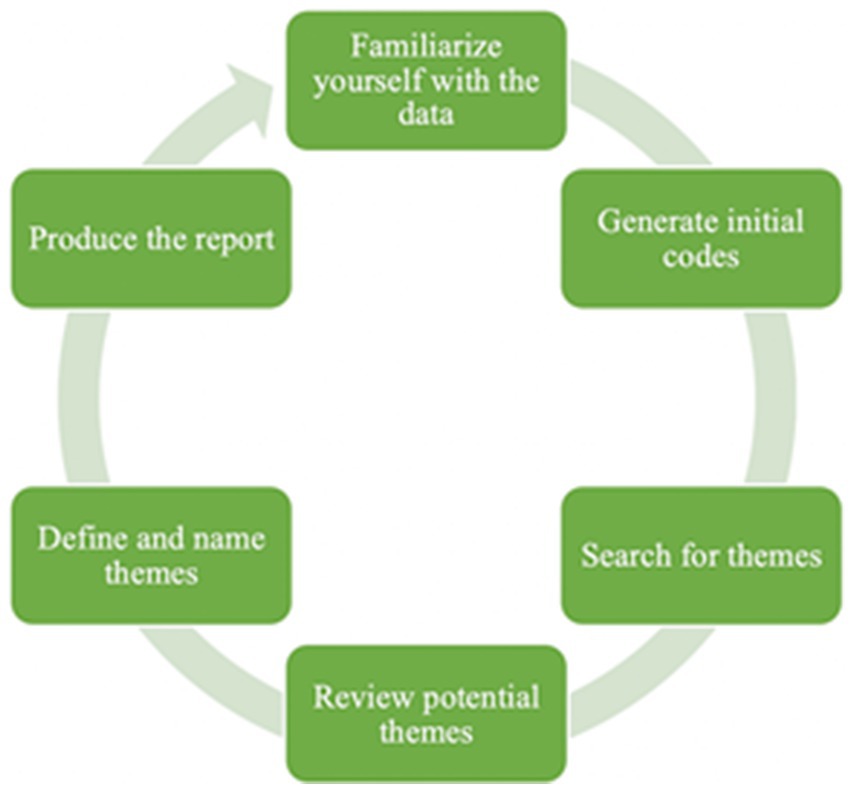
Figure 2. Thematic analysis framework (adapted from Braun and Clarke, 2006).
Although we followed a structured six-phase progression, our analysis was recursive, often moving back and forth between phases. After completing the six phases, we conducted a thorough analysis, crafting detailed narratives for each identified theme and assessing their relevance to the research question.
4.7 Research sites for phase 2
The four schools in the rural setting of what was once called Mount Fletcher, known as Tlokoeng since March 2022, lie within the Joe Gqabi District (Elundini Local Municipality), Eastern Cape province. The community relies primarily on government social grants and subsistence farming. These schools are classified under a Quintile 1 ranking, serving the poorest 20% of households in South Africa. Typically found in rural and remote areas, Quintile 1 schools receive free or subsidised educational services.
5 Results
We interpreted the respondents’ self-reported TPACK mean scores from the five-point Likert scale using Fisher and Marshall’s (2009) classification. The classification of mean scores is presented in Table 5.
5.1 Teachers’ TPACK perceptions
Understanding teachers’ TPACK was crucial because while they may have positive perceptions of technology, the meaningful adoption of such technology could be hindered by a lack of knowledge and skills to teach with it effectively. Therefore, in our context, TPACK underscores the importance of teachers acquiring the necessary expertise to integrate VLs into their teaching successfully. Table 6 presents the descriptive statistics for each TPACK domain.
Table 6 displays mean, standard deviation, minimum, and maximum values for six TPACK domains categorised into non-technology and technology groups. Non-technology domains scored higher mean (> 3.8) and lower standard deviation values (CK: M = 4.3091, SD = 0.4623; PK: M = 4.2520, SD = 0.3832; PCK: M = 3.8796, SD = 0.6841), indicating robust subject and pedagogical knowledge. Conversely, technology-related domains scored lower (TK: M = 3.4427, SD = 1.0000; TPK: M = 2.9875, SD = 1.0377; TPACK: M = 3.0269, SD = 0.9648), suggesting a need for improvement. Figure 3 offers a graphical overview of these statistics.
The respondents demonstrated strength in the TK domain (M = 3.4427, SD = 1.0000), which decreased when combined with other constructs to form TPK (M = 2.9875, SD = 1.0377) and TPACK (M = 3.0269, SD = 0.9648). This suggests proficiency in PK and CK compared to other areas, highlighting the importance of subject content expertise in teaching. We analysed each domain and triangulated the findings with qualitative results to provide a complete understanding of life sciences teachers’ TPACK.
5.1.1 Technological knowledge
The questionnaire asked the respondents to respond to seven items for TK. These statements are shown in Table 7, with their results.
The statistical data in Table 7 indicate that the statement with the highest mean rating for TK was on respondents’ “ability to learn technology easily” (M = 3.823, SD = 1.0218). This finding suggests their adaptability and willingness to explore new technological tools in the classroom. This finding was supported by data from the semi-structured interviews, where participants emphasised the ongoing need to stay abreast of technological advancements in education:
Staying abreast of new technological advancements is crucial for teachers. Therefore, I must continually educate myself on the latest technology trends to effectively use tools like Virtual Lab in class (LST2).
Oh man, have you noticed how many new educational technologies keep popping up these days? Just when you think you have the hang of one, they introduce a new one! So, you have to make sure you are always updating yourself (LST4).
LST2 and LST4 underscored teachers’ recognition of the necessity for ongoing self-development to remain abreast of advancements. Additionally, survey results indicate a high level of comfort among respondents in relation to employing various technologies in their teaching. This is evidenced by consistent scores across items such as “I often play around with technological tools” (M = 3.387, SD = 1.1858), “I know which technologies would work best for my life sciences teaching” (M = 3.306, SD = 1.1331), and “I can teach using different technologies” (M = 3.306, SD = 1.1331). These findings suggest that teachers possess confidence in their technological abilities and are adept at integrating educational technologies into their teaching methodologies. However, the questionnaire results reveal a lower mean score for teachers’ knowledge of “a lot of different technological tools” (M = 3.134, SD = 1.2426), indicating that some may lack confidence in their familiarity with various technological tools. The notable standard deviation for this item (SD = 1.2426) suggests significant variability in respondents’ levels of TK, with some demonstrating higher proficiency than others. The interview data corroborate this finding, with some participants expressing a lack of basic technological skills to operate various technologies:
We may not know how to use digital tools effectively for teaching purposes, including how to implement them and share information on widely available platforms (LST3).
LST3’s remarks emphasise the importance of a strong TK foundation for other technology-related knowledge domains such as TPK and TPACK. This suggests that despite frequent technology use, teachers may still require skills to keep pace with emerging tools. However, the study found teacher technology training inadequate, often lacking integration of pedagogy, content, and technology knowledge. Thus, teachers need training to develop TK for confident technology use in teaching. Interviews with the four rural school life sciences teachers revealed their desire for training prioritising technology integration into pedagogy for improved learning outcomes. They stressed the need to understand how to incorporate tools such as VLs into their curriculum effectively:
Teachers require support and training in utilising technology for teaching in addition to their existing pedagogical knowledge (LST1).
The statistical analysis revealed that respondents demonstrated a high level of TK and proficiency in utilising various technologies. With an overall mean rating of 3.4427 (SD = 1.0000), these teachers exhibited a strong familiarity with technological tools, indicating readiness to address the technological requirements of modern teaching practices, including those involving VLs. The subsequent section discusses the survey results pertaining to CK.
5.1.2 Content knowledge
The questionnaire asked the participants to respond to six question items concerning their CK. Table 8 displays the results.
Table 8 displays respondents’ responses regarding their CK. The highest mean rating was for “I am familiar with the life sciences content that CAPS prescribes” (M = 4.462, SD = 0.5314), indicating strong familiarity with CAPS subject matter. Additionally, “sufficient knowledge to answer most learners’ life sciences questions” scored high (M = 4.376, SD = 0.5679), suggesting respondents’ confidence in addressing learners’ queries. Conversely, “I have many ways and approaches to increase my own understanding of life sciences” had the lowest mean rating (M = 4.167, SD = 0.5190), with the low standard deviation indicating firm agreement among respondents. Overall, findings suggest high CK levels among respondents, with the CK construct receiving a very high mean rating (M = 4.3091) and low SD value (0.4623), indicating consistent responses. While subject specialisation is expected for life sciences teachers, future studies may explore teachers’ actual CK using objective measures for a comprehensive understanding of their competencies.
5.1.3 Pedagogical knowledge
The questionnaire asked the participants to respond to the eight question items concerning their PK, and Table 9 displays the results.
Table 9 sheds light on the respondents’ PK. Mean ratings for all PK statements exceeded 4, indicating respondents’ confidence in guiding learners and supervising their progress. The item “I can organise and maintain class management and control” received the highest mean rating (M = 4.409, SD = 0.5833), emphasising the importance of effective class management. Respondents were also familiar with the prescribed life sciences textbooks and learning resources (M = 4.285, SD = 0.5877). However, the lowest mean value was for the item related to assessing learners’ performance in life sciences (M = 4.102, SD = 0.5554), although respondents believed that they could conduct assessments. Overall, respondents reported high PK levels, with an overall mean of 4.2520 and high agreement for individual items (SD = 0.3832). These high mean scores suggest respondents’ confidence in challenging learners’ thinking and effectively teaching life sciences.
5.1.4 Pedagogical content knowledge
The questionnaire requested the respondents to respond to the five PCK items, and Table 10 displays the results.
Table 10 comprehensively analyses the respondents’ PCK levels, including mean ratings and standard deviation values. Individual item mean ratings exceeded 3.5, indicating high PCK levels among the respondents. The item with the highest mean score was respondents’ “knowledge to teach life sciences using audios and videos, e.g., from YouTube” (M = 4.145, SD = 0.7465), highlighting the importance of multimedia resources in life sciences teaching. This was followed closely by three items with similar means, all indicating very high self-reported PCK levels among respondents. These were: “I know which life sciences concepts/topics to teach using simulations” (M = 3.876, SD = 0.8059), “I have the knowledge to teach life sciences using digital boards, e.g., data projectors and smartboards” (M = 3.876, SD = 1.0031), and “I can teach specific life sciences concepts/topics using specific virtual lab experiments” (M = 3.855, SD = 0.9616). However, the lowest mean rating was for “I have the knowledge to teach life sciences using virtual labs on mobile devices such as cell phones, tablets, and iPads” (M = 3.645, SD = 1.0413). Similarly, during the semi-structured interviews, two participants expressed low level of ability to teach with VLs, with LST3 stating:
While I believe that Virtual Lab can simplify my teaching, the challenge lies in its unfamiliarity to many of us. As a result, I have encountered numerous complexities, and we need to put time into comprehending how to use them in teaching.
The statement underscores the need for teacher training in utilising VLs, including on mobile devices, to enhance learning. Overall, the PCK mean score was high (M = 3.8796, SD = 0.6841), indicating respondents’ ability to connect pedagogy and content knowledge effectively. While teachers show competence in various teaching strategies and resources to improve learners’ outcomes in life sciences, there is room for improvement in areas such as incorporating VLs.
5.1.5 Technological pedagogical knowledge
The questionnaire requested the respondents to respond to the three TPK items, and Table 11 shows the results.
The statistical analysis revealed that of all six TPACK domains, TPK received the lowest mean score (M = 2.9875, SD = 1.0377). This indicates neutral to disagreeing responses from the respondents regarding TPK items, particularly its use with VLs as a pedagogical tool. To explore TPK further, Table 11 displays the results of the three individual TPK items, with mean values ranging from 2.790 to 3.102, indicating low to moderate confidence in integrating VLs into pedagogy. Among the items, “I can select technologies that enhance learners’ understanding of a lesson” had the highest mean value (M = 3.102), although the high standard deviation (SD = 1.1509) suggests varied perceptions among respondents. In the interviews, participants highlighted the potential of technology to aid learners in understanding challenging topics. Specifically, LST2 emphasised the usefulness of VLs in enhancing comprehension:
Virtual Lab has helped me teach complex concepts more effectively. Its visual aids create a realistic and tangible learning experience for my learners. Specifically, topics like accommodation and breathing movement are easier to understand with the help of Virtual Lab (LST2).
These forward-thinking teacher participants actively seek strategies to enhance the teaching of complex or abstract concepts for the learners’ benefit. Further examination of individual TPK statements revealed that the lowest mean rating (M = 2.790, SD = 1.1266) is attributed to the item “I always think critically about how to use virtual lab in my life sciences class.” This indicates uncertainty or lack of confidence among the respondents in critically utilising VLs. The high standard deviation (SD = 1.1266) suggests significant variation in responses. In the semi-structured interviews following the survey, participants expressed the need for technology training to focus not only on technical aspects but also on incorporating technology into effective teaching. They articulated the desire for professional teacher development opportunities, prioritising technology integration into pedagogy:
Virtual Lab aims to enhance the accessibility, interactivity, and engagement of science education. As part of teacher professional development, there should be a deliberate focus on integrating technology into teaching (LST3).
Professional development programmes should focus on developing technical competencies for using technology tools and utilising technology to enhance pedagogy (LST2).
The overall TPK mean score (M = 2.9875, SD = 1.0377) suggests low levels of ability among respondents to select aspects of VL experiments that can enhance their teaching. These findings are unsurprising considering the novelty of VLs, with much still unknown about its potential to improve teaching. With increased adoption and use of VLs, it is expected that most life sciences teachers in rural schools will develop higher TPK levels necessary for effective teaching with this tool.
5.1.6 Technological pedagogical content knowledge
The questionnaire asked the participants to respond to the three TPACK items, and Table 12 shows the results.
The statistical analysis revealed an overall mean rating for TPACK of 3.0269 (SD = 0.9648). Across all individual TPACK items, the mean scores surpassed 3.0, indicating a range from moderate to high TPACK levels. This suggests that respondents demonstrated a fair level of confidence in their capacity to integrate various teaching strategies with life sciences concepts/topics through science experiments in VLs (M = 3.038, SD = 0.9884). Similarly, it indicates that respondents can effectively integrate “the content with technological skills using science experiments in virtual lab” (M = 3.032, SD = 1.0076). In the semi-structured interviews, participants elaborated on the factors shaping their decisions regarding which experiments to utilise in the VL and when to implement them. Their responses encompassed the following insights:
I can say I am able to choose the experiments that can specifically help reinforce [learners’] understanding of a certain topic (LST1).
I think proper lesson planning is key to teaching well. So, before my lessons, I try out a bunch of experiments in Virtual Lab to find the ones that are just right for my students. Some of them can be too hard, but I check the CAPS document to see which ones are suitable for their level (LST4).
The statements showcase participants’ confidence in their TPACK levels for VL teaching. LST1’s intent to incorporate VLs in lesson planning is notable. Survey results and interviews affirm the participating teachers’ ability to adapt VL experiments to meet diverse student needs (M = 3.011, SD = 1.0449). An interview excerpt confirms this finding:
I really appreciate the flexibility of Virtual Lab because it allows me to modify and customise experiments better to fit the needs and abilities of my students. I can simplify or add more complexity as necessary, and it is all in one convenient platform (LST2).
Moreover, analysis of the TPACK items indicated standard deviation values above 1.0, suggesting more variation in the respondents’ responses. Notably, when compared with other technology-related domains, the overall TPACK domain mean (M = 3.0269, SD = 0.9648) slightly exceeded that for TPK (M = 2.9875, SD = 1.0377), but was lower than the TK mean score (M = 3.4427, SD = 1.0000). This is an exciting finding, as it suggests that the teachers in this research held that they could integrate VLs in their classroom despite their competence in utilising it being lower.
6 Discussion
Understanding TPACK in the context of VL adoption in rural secondary schools in South Africa is a significant yet underexplored area of educational research. Rural schools have traditionally faced unique challenges, including limited access to resources and technology infrastructure and low competency in the integration of digital tools into teaching. Exploring TPACK in this setting holds both academic significance and practical implications for improving educational access and quality in marginalised areas. An additional strength of this paper is its assessment of the individual TPACK components rather than focussing solely on the overall TPACK. This approach allows for a nuanced understanding of teachers’ strengths and weaknesses, facilitating targeted professional development efforts tailored to specific needs. Moreover, this approach can foster collaboration among teachers; specifically, teachers who excel in certain areas can share their knowledge and strategies with colleagues who may need support in those areas. This collaborative approach can foster a culture of continuous learning and improvement within educational communities.
This paper examined teachers’ self-reported levels of TPACK across six domains, categorised into two groups: non-technology domains (CK, PK, and PCK) and technology-related domains (TK, TPK, and TPACK). Notably, the non-technology domains yielded higher mean scores, indicating a solid understanding of subject matter and teaching methods among life sciences teachers. Conversely, the technology-related TPACK domains yielded lower average scores. This study validates prior research by Koehler and Mishra (2006), Hill and Uribe-Florez (2020), and Mensah et al. (2021), which notes that practising teachers often demonstrate higher proficiency in CK, PK, and PCK compared to their grasp of TK, TPK, and TPACK. This observation raises the question of when teachers in rural schools will develop and exhibit superior competence in technology-related TPACK areas. The higher mean scores for non-technology domains compared to the technology-related constructs suggest that life sciences teachers have a firmer grasp of their subject matter and teaching methodologies than their technological expertise. This outcome was expected, given the emphasis of South Africa’s teacher training system on requiring teachers to hold degrees in specific subjects. Furthermore, professional development initiatives prioritise workshops addressing content gaps and enhancing pedagogical skills, further reinforcing teachers’ proficiency in CK, PK, and PCK. This observation supports Kumala et al. (2022), who found a positive correlation between teachers’ TPACK levels and their teaching experience, suggesting an enhancement in TPACK proficiency with increased teaching experience.
Interestingly, while Handika et al. (2023) found that TPACK exhibited the highest mean value, implying ease in integrating all the TPACK components, our research indicates otherwise and uncovered a nuanced perspective. We found that, despite demonstrating a solid grasp of TK independently, the teachers in our study encountered challenges when merging it with CK and PK, garnering a low TPACK mean score. This finding diverges from the conclusions drawn by Handika et al. (2023). This contradiction highlights varying perceptions regarding the teachers’ self-reported TPACK levels. Furthermore, this contradiction prompts reflection on the evolving nature of teaching practices in the digital age. It suggests that while some teachers may find integrating technology into their pedagogical approaches relatively straightforward, others may encounter significant obstacles. These findings indicate that rural school teachers, while being familiar with technology, are still developing their ability to integrate it with pedagogical and content expertise. This aligns with the global dialogue on teaching in the digital age, emphasising the need for effective professional development to ensure that teachers can enrich 21st century learning. Expanding on Koehler and Mishra’s (2006) prior research, our study enhances the understanding of TPACK in varied educational environments, notably in underexamined rural schooling settings.
7 Conclusion
This paper has pioneered an investigation focussing on understanding teachers’ TPACK in rural schools in the context of VL adoption. While teachers demonstrate strong CK and PK, which are foundational for TPACK development, the integration of technology with these domains requires attention and support. The paper has revealed a concerning lack of TPACK among teachers in rural schools, highlighting the urgent need for improved competencies in technology integration. Proposed solutions include tailored professional development programmes and increased adoption of technology. Moreover, despite teachers’ proficiency in non-technology areas such as CK, PK, and PCK, there is a significant gap in technology-related TPACK domains such as TK, TPK, and TPACK. These findings underscore the global discourse on the need for teachers to possess the necessary expertise to leverage technology into teaching. In conclusion, the paper emphasises the significance of focussing on specific TPACK domains rather than a generalised approach. This targeted focus can offer deeper insights into TPACK development and better support rural secondary school science teachers in enhancing their technological integration skills.
8 Implications
Examining TPACK in rural secondary schools is an emerging research area in South Africa. This paper represents the inaugural step in examining TPACK among rural school teachers, laying the groundwork for future investigations. The nuanced perspectives garnered from rural school science teachers offer invaluable insights for crafting targeted interventions and support mechanisms. These findings can inform policymakers on devising professional development strategies to foster TPACK among teachers, thereby ensuring equitable educational access in remote regions. The implications of this research transcend borders, contributing to global dialogues on integrating educational technology across diverse learning landscapes, including rural and marginalised areas. South African rural schools serve as rich learning environments, offering valuable lessons for teachers, researchers, and policymakers worldwide. Beyond academic implications, this research highlights several practical implications and actionable insights for enhancing teachers’ TPACK to effectively utilise VL in rural schools. Notably, the study underscores the need for targeted professional development programmes that integrate technology with pedagogy and content knowledge, tailored specifically to the needs of rural teachers. Additionally, strategic resource allocation is crucial to bridge the technological gap, including providing reliable internet access, modern devices, and technical support. Moreover, establishing collaborative learning communities among rural teachers can facilitate the sharing of best practices and ongoing support, fostering continuous improvement in TPACK. Also, curriculum adaptation is crucial, involving the creation of context-specific lesson plans and activities that leverage VL to enhance learning outcomes. Finally, policymakers should provide support through policies that promote VL integration, offering incentives for technology adoption and grants for professional development.
9 Limitations
While the current study sheds light on self-reported TPACK levels among teachers in rural schools, it is essential to acknowledge its inherent strengths and limitations. One limitation lies in the data collection timeframe, with data collection occurring during a particularly demanding period for teachers. This timeframe coincided with the pressure to cover the curriculum for year-end examinations, potentially affecting the thoroughness of the teachers’ responses to the questionnaires and interviews. Furthermore, the generalisability of the results may be limited due to the specific context of rural schools. The unique challenges and features of rural education settings could mean that our findings may not be applicable to urban or suburban schools. Additionally, potential biases could have influenced the data, such as the self-reported nature of the survey or interview responses and the possibility of social desirability bias, where the participants may have provided answers they perceived as favourable. Moreover, the relatively small sample size may also affect the internal and external validity of the study, as it might not fully capture the diversity of experiences and perspectives among rural teachers. Importantly, the rapidly evolving nature of technology in education means that findings might become outdated as new tools and practices emerge. These factors should be considered when interpreting the results and applying them to broader contexts. Despite these limitations, the study offers valuable insights into the TPACK landscape among rural school teachers.
10 Future studies
Future research in this area should aim to delve deeper into understanding the specific factors that contribute to the lack of TPACK among teachers in rural schools. This exploration would help identify both barriers and facilitators to effective technology integration in these settings. Additionally, there is a need to investigate the effectiveness of various professional development models and strategies tailored specifically to rural contexts. Longitudinal studies could provide valuable insights into how teachers’ TPACK evolves over time and the impact of sustained support initiatives. Comparative research across different regions and educational systems would offer useful perspectives on the variations in TPACK development and the effectiveness of interventions. Furthermore, exploring innovative approaches to integrating technology into teacher education programmes could better equip PSTs with TPACK. Lastly, examining the influence of contextual factors such as infrastructure, access to resources, and community support on TPACK development would contribute to a more comprehensive understanding of the challenges and opportunities in enhancing technology integration in rural schools.
Data availability statement
The raw data supporting the conclusions of this article will be made available by the authors, without undue reservation.
Ethics statement
The studies involving humans were approved by the General/Human Research Ethics Committee (GHREC). Ethical clearance number: UFS-HSD2022/1276/22. The studies were conducted in accordance with the local legislation and institutional requirements. The participants provided their written informed consent to participate in this study.
Author contributions
BS: Conceptualization, Data curation, Formal analysis, Investigation, Methodology, Project administration, Resources, Supervision, Validation, Visualization, Writing – original draft, Writing – review & editing. TJ: Conceptualization, Data curation, Formal analysis, Investigation, Methodology, Project administration, Resources, Software, Supervision, Validation, Visualization, Writing – original draft, Writing – review & editing.
Funding
The author(s) declare that no financial support was received for the research, authorship, and/or publication of this article.
Conflict of interest
The authors declare that the research was conducted in the absence of any commercial or financial relationships that could be construed as a potential conflict of interest.
Publisher’s note
All claims expressed in this article are solely those of the authors and do not necessarily represent those of their affiliated organizations, or those of the publisher, the editors and the reviewers. Any product that may be evaluated in this article, or claim that may be made by its manufacturer, is not guaranteed or endorsed by the publisher.
References
Braun, V., and Clarke, V. (2006). Using thematic analysis in psychology. Qual. Res. Psychol. 3, 77–101. doi: 10.1191/1478088706qp063oa
Cíbiková, I., and Petrášová, B. (2023). Teaching terminology of science. INTED 1452, 6–8. doi: 10.21125/inted.2023.1452
Cliff, N. (1984). An improved internal consistency reliability estimate. J. Educ. Stat. 9, 151–161. doi: 10.3102/10769986009002151
Cohen, L., Manion, L., and Morrison, K. (2017). “Observation” in Research methods in education (London: Routledge), 542–562.
Cox, J. (2013). Tenured teachers & technology integration in the classroom. Contemp. Issues Educ. Res. 6, 209–218. doi: 10.19030/cier.v6i2.7730
Cronbach, L. J. (1951). Coefficient alpha and the internal structure of tests. Psychometrika 16, 297–334. doi: 10.1007/BF02310555
Drescher, J., Podolsky, A., Reardon, S. F., and Torrance, G. (2022). The geography of rural educational opportunity. RSF J. Soc. Sci. 8, 123–149. doi: 10.7758/RSF.2022.8.3.05
Fisher, M. J., and Marshall, A. P. (2009). Understanding descriptive statistics. Aust. Crit. Care 22, 93–97. doi: 10.1016/j.aucc.2008.11.003
Hajjar, S. T. (2018). Statistical analysis: internal-consistency reliability and construct validity. Int. J. Quant. Qual. Res. Methods 6, 27–38. doi: 10.15091/ijqqrm.2018.v6i1.617
Handayani, S., Hussin, M., and Norman, M. (2023). Technological pedagogical content knowledge (TPACK) model in teaching: a review and bibliometric analysis. Pegem J. Educ. Instr. 13, 176–190. doi: 10.47750/pegegog.13.03.19
Handika, R. F., Agustin, M., and Jakawali, G. (2023). TPACK component analysis (technology, pedagogics, content knowledge) in elementary school teachers as a framework for teacher competence in 21st-century learning. Int. Conf. Elementary Educ. 5, 545–551.
Hill, J. E., and Uribe-Florez, L. (2020). Understanding secondary school teachers’ TPACK and technology implementation in mathematics classrooms. Int. J. Technol. Educ. 3, 1–13. doi: 10.46328/ijte.v3i1.8
Ingersoll, R. M., and Tran, H. (2023). Teacher shortages and turnover in rural schools in the US: an organisational analysis. Educ. Adm. Q. 59, 396–431. doi: 10.1177/0013161X231159922
Jita, T. (2016). Pre-service teachers’ competence to teach science through information and communication technologies in South Africa. Perspect. Educ. 34, 15–28. doi: 10.18820/2519593X/pie.v34i3.2
Koehler, M. J., and Mishra, P. (2006). What happens when teachers design educational technology? The development of technological pedagogical content knowledge. J. Educ. Comput. 322, 131–152. doi: 10.2190/0EW7-01WB-BKHL-QDYV
Koehler, M., and Mishra, P. (2009). What is technological pedagogical content knowledge (TPACK)? CITE 91, 60–70. doi: 10.1177/0963297X0900900106
Kumala, F. N., Ghufron, A., and Pujiastuti, P. (2022). Elementary school teachers’ TPACK profile in science teaching based on demographic factors. Int. J. Instr. 15, 77–100. doi: 10.29333/iji.2022.1545a
Leahy, S., and Mishra, P. (2023). “TPACK and the Cambrian explosion of AI” in Society for Information Technology & teacher education international conference (Waynesville, NC USA: Association for the Advancement of computing in education (AACE)), 2465–2469.
Lombardi, D., and Bailey, J. M. (2024). “Science learning and teaching,” in Handbook of Educational Psychology, eds., Schutz, P. A., and Muis, K. R. (London: Routledge), 531–552.
Lynch, T., and Ghergulescu, I. (2017). Review of virtual labs as the emerging technologies for teaching STEM subjects. INTED 8, 6082–6091. doi: 10.21125/inted.2017.1422
Masinire, A. (2020). “The historical burden of rural education: reflections of colonial legacy on current rural education in South Africa,” in Rurality, Social Justice and Education in Sub-Saharan Africa Volume I: Theory and Practice in Schools (Cham: Palgrave Macmillan), 27–38.
Mensah, B., Poku, A. A., and Quashigah, A. Y. (2021). Technology integration into the teaching and learning of geography in senior high schools in Ghana: a TPACK assessment. Soc. Educ. Res. 3, 80–90. doi: 10.37256/ser.3120221218
Mercado, J., and Picardal, J. P. (2023). Virtual laboratory simulations in biotechnology: a systematic review. Sci. Educ. Int. 34, 52–57. doi: 10.33828/sei.v34.i1.6
Mishra, P. (2019). Considering contextual knowledge: the TPACK diagram gets an upgrade. J. Digit. Learn. Teach. Educ. 35, 76–78. doi: 10.1080/21532974.2019.1588611
Mishra, M., Gorakhnath, I., Lata, P., Rani, R., and Chopra, P. (2022). Integration of technological pedagogical content knowledge (TPACK) in classrooms through a teacher’s lens. Int. J. Health Sci. 6, 12505–12512. doi: 10.53730/ijhs.v6ns3.9536
Mishra, P., Phillips, M., Baran, E., Koehler, M., Harris, J., and Williams, M. (2024). “Part 1: the past, present, and most importantly the future of TPACK” in Proceedings of Society for Information Technology & teacher education international conference. eds. J. Cohen and G. Solano (Las Vegas, NV: Association for the Advancement of Computing in Education (AACE)), 2443–2448.
Omoso, E., and Odindo, F. (2020). TPACK in teacher education: using pre-service teachers’ self-reported TPACK to improve pedagogic practice. Int. J. Educ. Res. 8, 1–10.
Paristiowati, M., Nurhadi, M. F., and Imansari, A. (2020). Analysis of technological pedagogical and content knowledge (TPACK) of prospective chemistry teachers through lesson study. J. Phys. Conf. Ser 1521:042069. doi: 10.1088/1742-6596/1521/4/042069
Paulsen, J., and Brcka Lorenz, A. (2017). Internal Consistency. FSSE Psychometric Portfolio. Available at: https://hdl.handle.net/2022/24498 (Accessed April 25, 2024).
Potkonjak, V., Gardner, M., Callaghan, V., Mattila, P., Guetl, C., Petrović, V. M., et al. (2016). Virtual laboratories for education in science, technology, and engineering: a review. Comput. Educ. 95, 309–327. doi: 10.1016/j.compedu.2016.02.002
Pyatt, K., and Sims, R. (2012). Virtual and physical experimentation in inquiry-based science labs: attitudes, performance and access. J. Sci. Educ. Technol. 21, 133–147. doi: 10.1007/s10956-011-9291-6
Reginald, G. (2023). Teaching and learning using virtual labs: investigating the effects on students’ self-regulation. Cogent. Educ. 10:2172308. doi: 10.1080/2331186X.2023.2172308
Schmidt, D. A., Baran, E., Thompson, A. D., Mishra, P., Koehler, M. J., and Shin, T. S. (2009). Technological pedagogical content knowledge (TPACK): the development and validation of an assessment instrument for preservice teachers. J. Res. Technol. Educ. 42, 123–149. doi: 10.1080/15391523.2009.10782544
Setiawan, H., Phillipson, S., and Isnaeni, W. (2019). Current trends in TPACK research in science education: a systematic review of literature from 2011 to 2017. J. Phys. Conf. Ser. 1317:012213. doi: 10.1088/1742-6596/1317/1/012213
Shambare, B., Simuja, C., and Olayinka, T. A. (2022). Understanding the enabling and constraining factors in using the virtual lab: teaching science in rural schools in South Africa. Int. J. Inf. Commun. Technol. Educ. 18, 1–15. doi: 10.4018/IJICTE.307110
Shulman, L. S. (1986). Those who understand: knowledge growth in teaching. Educ. Res. 15, 4–14. doi: 10.3102/0013189X015002004
Shulman, L. (1987). Knowledge and teaching: foundations of the new reform. Harv. Educ. Rev. 57, 1–23. doi: 10.17763/haer.57.1.j463w79r56455411
Tran, H., and Smith, D. A. (2020). Designing an employee experience approach to teacher retention in hard-to-staff schools. NASSP Bull. 104, 85–109. doi: 10.1177/0192636520927092
Keywords: TPACK, virtual lab, technology, rural schools, science education
Citation: Shambare B and Jita T (2024) Understanding science teachers’ TPACK for virtual lab adoption in rural schools in South Africa: a mixed-methods approach. Front. Educ. 9:1426451. doi: 10.3389/feduc.2024.1426451
Edited by:
Osbaldo Turpo Gebera, National University of Saint Augustine, PeruReviewed by:
Wanda Nugroho Yanuarto, Muhammadiyah University of Purwokerto, IndonesiaSurattana Adipat, Ramkhamhaeng University, Thailand
Copyright © 2024 Shambare and Jita. This is an open-access article distributed under the terms of the Creative Commons Attribution License (CC BY). The use, distribution or reproduction in other forums is permitted, provided the original author(s) and the copyright owner(s) are credited and that the original publication in this journal is cited, in accordance with accepted academic practice. No use, distribution or reproduction is permitted which does not comply with these terms.
*Correspondence: Brian Shambare, c2hhbWJhcmVCQHVmcy5hYy56YQ==
 Brian Shambare
Brian Shambare Thuthukile Jita
Thuthukile Jita